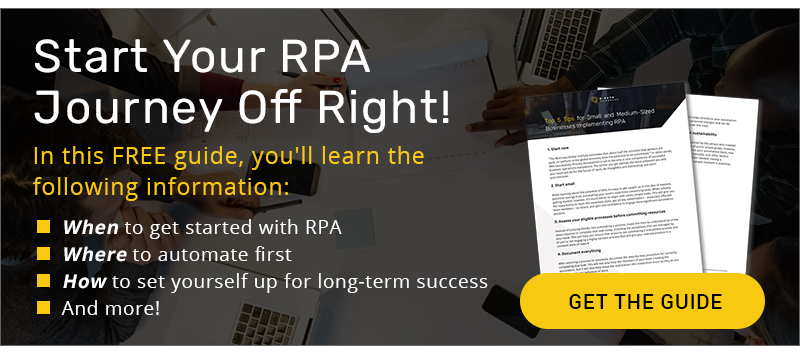Robotic Process Automation has proven its value across industries and companies of all sizes, and its adoption only accelerated with the changes to work necessitated by the pandemic. Even so, there remains abundant opportunity for mid-sized businesses in particular to implement RPA, and it’s important to understand how to quickly achieve ROI.
For the uninitiated, RPA bots are custom-coded software that boost productivity by completing high-demand, mundane tasks from across your organization – the kind your people would rather not do anyway. These digital workers perform the routine tasks so your employees are free to do work that requires judgement, collaboration, empathy, and creativity. In this way, RPA improves your company’s efficiency and increases the value generated by your employees.
If you’re looking to begin an automation initiative in your company and generate a fast ROI from your investment, here are three recommendations to bear in mind:
#1: Assemble an Effective RPA Team
As they say, teamwork makes the dream work. To truly create impact and ROI using RPA, you must be strategic. Assembling an RPA team experienced in automation and process optimization is critical as they’re able to identify the best immediate and long-term solutions. Key roles on your team should include:
- Business Analyst: This person establishes a metrics baseline and measures the bots’ impact over time.
- Process Engineer: This person evaluates the process before automation so you don’t end up automating a bad process.
- Solutions Architect: This role figures out how the automation will actually work. There are many ways to accomplish the same thing, but not all are created equal. This person thinks through edge cases and failure scenarios.
- RPA Developer: This low-code developer writes and tests the code itself.
Tip:
Be cautious when relying solely on citizen developers for your automation initiatives (e.g., asking your resident Excel expert to implement RPA). These workers are fine for small projects that they manage directly, but they’re not always suited for a full-scale automation program due to the critical need for ongoing maintenance.

#2: Implement the Right Infrastructure
Just as specific software platforms are required for proper word processing (e.g., Microsoft® Word, Google® Docs, etc.), RPA implementations also require an underlying software platform. There are many platforms to choose from, and most offer the same core functionality, but there are numerous feature differences that will require your due diligence to confirm they will integrate with your existing systems and support the business outcomes you wish to achieve.
When shopping for an RPA platform, be sure to consider the following points:
- Does the platform have the functionality you need to support your current and expected future needs? This may include Natural Language Processing (NLP), automated process discovery, built-in dashboarding for analytics, etc.
- Since you will need to rely on this platform for years to come, does it come from one of the top RPA platform providers? If your chosen provider goes out of business, you will need to rebuild all of your automations, so the stability and longevity of your platform provider is essential.
- Does the platform allow you to start small and add additional bots and functionality as needed, or does it require a substantial investment up front for capabilities you may not quite be ready for? Having a platform that scales with you is extremely beneficial.
Selecting and implementing the right RPA platform is vital to ensure your automations are up and running quickly, helping you achieve ROI as soon as possible.
#3: Identify Ideal Processes
While you must find the right team to handle the logistics of implementing RPA, there’s much to be said for finding the best processes to automate as well. To get the most mileage at the beginning of an RPA deployment, you’ll want to determine tasks that are consistent and rules-based for the bots to do. As a helpful rule of thumb, anything that’s a batch process will likely prove effective.
Additionally, the fewer employees, teams, or departments that are impacted, the easier it will be to generate fast results. Automating even a portion of a larger process such as a loan or job application yields impressive results early on.
R-Path Automation clients have seen great results with tasks such as:
- Reconciling patient data in healthcare
- Processing loan applications in the financial sector
- Processing payroll data for hourly workers
- Onboarding employees
- Verifying and updating data collected from websites and web-based applications
Removing these routine and mundane tasks from your employees can make a huge difference in employees feeling more engaged and challenged at work. In today’s world, it’s just as important to stay efficient as it is to retain your workforce; constantly hiring can be expensive.
RPA has been proven to make a difference for organizations of all sizes. With a bit of planning and collaboration, bots can replace repetitive tasks and open up more opportunity for innovation, all while delivering a quick ROI.
Interested in learning more? Explore more of our free resources here to see all the ways RPA can work for your business.

